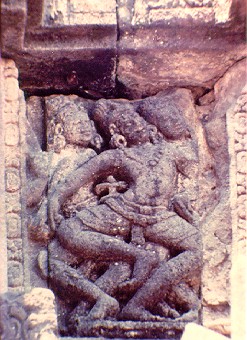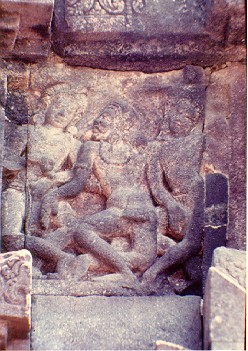


middle: Figure 9: Relief P8
right: Figure 10: Relief P40
We began our work with the sequence seen in relief 49 (figure 5). As a source for the movement analysis, first we used video clips and live interpretations/demonstrations of the reconstructed dance sequence of relief 49 performed by the reconstructor. The video material helped us to understand issues connected with the interpretation of the sequence, specifying details in the transitions, tempo, flow of the energy and in capturing the distinctive quality of the movement of this particular dance mode. The dance motif (dance pattern) was easy to reconstruct but to achieve the distinctive style with the required movement quality was more difficult.
The creation of the dance sequences was done in three phases:
The recording had to be done several times and we ended up with three versions. Version I was too fast and there were inaccuracies with the head tilt and the position of the legs. Also, the beginning was missing. Version II showed better timing, a more accurate motif, better transitions. Version III was based on a Javanese dancer's interpretation and represents the final recording. This was done twice, showing the dancer without a costume in the first version and with a costume, copied from the one seen in relief 49, in the second recording.
The problems encountered were to do with accurate manipulation of the joints and body parts in the Figure Editor and also with smooth transitions, shifts of weight, sliding and appropriate timing. Some 38 versions of the animation of one sequence were made to explore all possibilities.
Creating a realistic human figure is one of the most difficult things to do in 3D software. We could not solve this problem in the limited time during which the project ran. We have, however, experimented with LifeForms' own rendering facilities and have begun to think of ways of getting round this problem. One possibility is to digitise the reliefs and then proceed with building the corresponding surfaces. This would be followed by transformation of the reconstructed object(s) into a form which may be imported into LifeForms and which would have enough flexibility in the joints to be able to move convincingly.
Over the 12 months during which this project ran (with an average work input of two days a week) we worked altogether on the animation of four sequences, with innumerable versions and variants. These were, apart from P49, sequences from reliefs P2, P8, P40 (Figures 8-10).



The work done on these sequences involved establishing appropriate timing and movement dynamics. We calculated a minimum of 16 hours work on each sequence was needed in order to begin to obtain accurate and reliable modelling6. (Movie 3, Movie 4, Movie 5).
However, in order to obtain the exact movement quality and flow of energy, we feel that motion-captured movement from a moving human body should be applied to the sequence. This is what can give a more realistic 'feel' to the figures. We have not been able to motion-capture the dancer's movements, owing to circumstances beyond our control, but this could be done in the context of future developments of this project. A major drawback is that the costs involved are very high.
Apart from the technical and technological problems mentioned, a number of fundamental issues have been identified, relating to movement perception and analysis.
When the reliefs were decoded and the movement patterns in each relief identified, the quality of the movement was irrelevant. When, however, we began to recreate the dance movements in LifeForms, the movement quality obtained was very specific to the animation programme. This was unlikely to approximate the original movement quality of this form of dance. We began to think about such issues from different perspectives.
There cannot be a dance reconstruction/recreation without movement quality; this is implicitly given to the reconstruction through the interpretation that is chosen. The appropriate movement quality cannot be gathered from textual material nor can it be fully obtained from decoding the reliefs, although in studying body positions and how these can be linked together it may be possible to infer some quality for the overall movement pattern. In other words, it became clear that interpretation of the movement quality to be given to the sequences was a crucial issue.
When we look at the way each of us moves, we become aware of our characteristics, our qualities, our attitudes, our relationship to time and space and the influence of our particular cultural background on the way we move. Movement without quality does not exist. A movement pattern is always subject to varying degrees of interpretation, depending on who is moving. The quality of movement and its interpretation is linked with socio-cultural issues, as research has shown (Bartenieff and Lewis 1983; Moore and Yamamoto 1988). How do we therefore determine the appropriateness of the movement quality to be chosen for the animation?
We decided to enlist the help of a dancer. The best option in this instance seemed to be that of having a Javanese male dancer, trained in Javanese traditional court dance, to execute the movement sequences. The gender choice was determined by the fact that the dancers in the reliefs are male. The dancer was Didik Bambang Wahyudi from STSI, Solo.
The question may be asked why a Javanese dancer with such training should be chosen. As we have seen, a codification is an abstract delineation of a pattern and does not involve quality. The quality can only be given by the moving human body. We were aware that a Javanese dancer from Central Java, trained in Javanese court dance, has mastery over a dance vocabulary built around movement interpretation in terms of movement quality in relation to characterisation. This previous training in a form that springs from the same geographical region as the temple complex and the reliefs, albeit several centuries later, and which emphasises interpretation, is extremely useful for the work that we were engaged in. It is not the technique of living traditions of Javanese court dance that is required for this reconstruction. but we were faced with the problem of giving some quality to the interpretation of an obsolete dance technique whose archaeological record is found in Java. We thought we would not be 'too wrong' if we chose to give it a 'Javanese' flavour. We chose to tap into the quality of the inculturated movement, the type of movement which is culture specific and is naturally absorbed as one grows up along with with language, accent and intonation 7. This is the 'movement base' on which the Javanese court dance training is built and we felt that we could use it as the movement base for our animation.
Why use a trained body rather than an untrained body, especially if what we were after was movement which is not acquired through any conscious and systematic training? To recreate in practice the dance movements of the Prambanan reliefs with fluency, the interpreter needs to have the controlled body of a trained dancer. Body control cannot be achieved without training and dancers, whatever their technique, by definition have this body control. Had the previous training of the dancer in question been in a technique other than Javanese dance, this would have changed the interpretation considerably8. The dance training of Didik Bambang Wahyudi, the dancer chosen to work on this project, helped him to tune in and reinterpret the reconstructed movements, adding nuances of quality which came partly from his aesthetic understanding of movement, based on the aesthetics of living traditions of Javanese court dance, and partly from his Javanese 'movement base'.
We openly admit a degree of arbitrariness in our choosing to work with a Javanese dancer of today. But it made little sense, for this project, to work with another dancer with a different background of dance training and with a different inculturated movement background, the interpretation would not have been contextually appropriate. It was these considerations which guided our choice.
It is also clear from this that the question of whether the dance seen in the Prambanan reliefs is Indian or Javanese, a question which has been debated for decades, is virtually meaningless, since it does not take the qualitative interpretation of movement into account. A good parallel can be provided by the art and architecture of ancient Java, which used an idiom with a connection with Indian art and architecture but infused it with an unmistakable Javanese flavour. Similarly, it is likely that dance karanas9 would have been interpreted in a different way in India and in Java (Iyer 1999; 2000) and this would have affected their overall performance.
© Internet Archaeology
URL: http://intarch.ac.uk/journal/issue10/iyer/process.html
Last updated: Fri Jun 1 2001